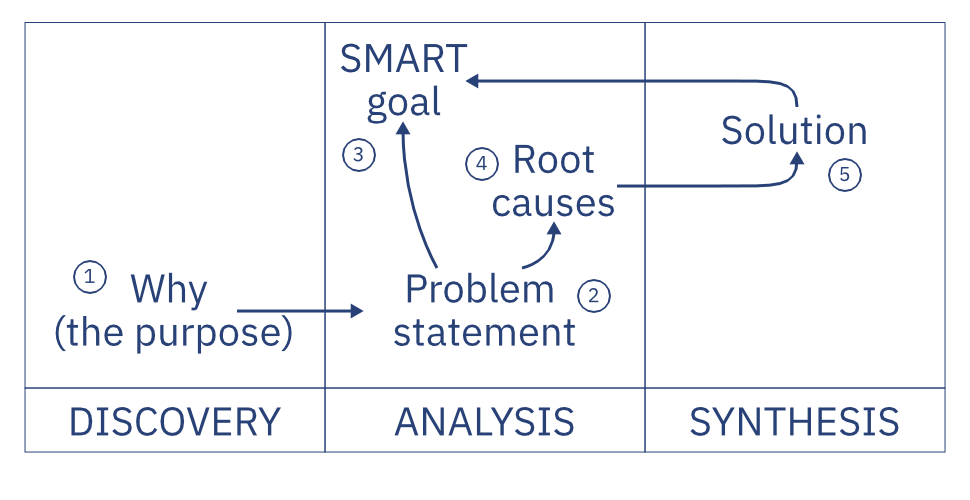Our approach to the consultancy service
Turning your pains into your advantage
We respect and appreciate that every customer we serve and every project we do is unique. We do not apply the "one size fits all" approach. When initiating a collaboration with you, our customer, we learn your culture, preferences, objectives and other factors impacting and influencing how we work together. With such knowledge, we customize our standard approach to maximize the value that we bring to you.
Our standard approach to provide the consultancy service breaks down to three phases: DISCOVERY, ANALYSIS and SYNTHESIS. A brief summary of each phase follows.
The budget, scope and timelines for each of these phases get defined when customizing the standard approach for your needs.

DISCOVERY

When a need for a change appears ...
It starts when a need for a change appears and it becomes a candidate for implementation. The desire for a change is usually powered by improving business performance (cost reduction or revenue increase or both). Other reasons for implementing a change in an organization include compliance, technology changes, crisis, mergers&acquisitions, etc.
... regardless of how big the change is ...
The change can be as simple as adjusting a workflow in a document management system (DMS) through deployment of a customer relationship management (CRM) system all the way to development and deployment of a new IT strategy.
... you need a business case ...
No matter how big or small the change is. We provide our consultancy service to work with you to slice and dice the change and to develop a case featuring the following information:
- Formal description of WHAT the problem (opportunity) is
- Evaluation of HOW MUCH it costs to maintain the status quo and
- Estimate of HOW MUCH it costs to address the problem (opportunity) and what benefits it brings
... to give the change its purpose ...
This is the first step to initiate a project (or a program) delivering the change. The case answers the question WHY the change should be implemented and thus it gives a PURPOSE to the project (and to the people involved in delivering the project).
... and thus enable its succesfull delivery
In our experience, many projects do not bring a business value and fail miserably because they were poorly initiated, they did not provide a solid answer as to WHY the project was needed. We recommend not to underestimate the importance of the initial stage and to develop a solid case which justifies the investment and which answers the fundamental question "why this solution is needed?"
ANALYSIS

Knowing the WHY ...
Understanding the purposes of a change, we may proceed to the next phase on the way to implement the change: ANALYSIS.
... we develop the goal ...
While analyzing the desired change, we develop a problem statement. It defines what gets solved by implementing the change. During the analysis phase we also combine the purpose of the change (a result of the discovery phase) with the problem statement to declare a goal - a definition of what exactly we want to achieve by implementing the change. For a change to be successfully implemented, the goal must be SMART: specific, measurable, achievable, relevant and time-bound.
... and identify root causes.
The problem statement is also used for root cause analysis. Knowing the root causes of the problem is an essential prerequisite for designing a good solution that enables achieving the goal. Using creative problem solving (CPS) techniques during the analysis phase is a good choice.
Appreciative inquiry
When serving our customers, we mostly use the problem solving approach as outlined above. However, we recognize the value of Appreciative inquiry and use it when applicable.
Do not underestimate the analysis
Our experience shows that organizations do not plan enough resources for the analysis phase. They take s shortcut (by skipping the analysis phase) and jump on designing solutions without understanding the problem at hand and its root causes.
SYNTHESIS

All clues come together...
Synthesis is the last stage of our consultancy approach when we organize all the clues collected so far to finally solve the puzzle and provide a different perspective of solving the problem at hand.
... to propose a solution ...
It is a structured high-level design document that describes the solution in terms of its objective and business requirements. These requirements are derived from the information collected during the DISCOVERY and ANALYSIS phases. The information is also captured in the document and it includes (but is not limited to) the following artifacts: business process, architecture, benefits, risks, stakeholder's map and training needs.
... that enables achieving the goal.
Designing solutions that have positive impact on your business is a must for us. Therefore we verify and validate the solution design against the goal as declared during the analysis phase. We do not release the solution design until it passes this check.
What comes next?
Having the high-level solution design document featuring the business requirements, you may run a tender to find a supplier of the solution. We will be honored if you invite us to the tender as we also deliver solutions (see our solution delivery service)